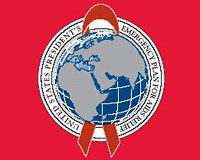| Monitoring and Evaluation (Updated August 2008) PDF version PDF version
 |
President George W. Bush's
Emergency Plan for AIDS
Relief is the largest commitment
ever by any nation for an
international health
initiative dedicated to
a single disease.
U.S. Department of
State
U.S. Agency for
International
Development
U.S. Department of
Defense
U.S. Department of
Commerce
U.S. Department of
Labor
U.S. Department of
Health and Human
Services
Peace Corps
Mailing address:
SA-29, 2nd Floor
2201 C Street, NW
Washington, DC 20522-2920
www.PEPFAR.gov
| |

Monitoring and Evaluation
Sustainable capacity for monitoring and evaluation (M&E) of HIV/AIDS programs at the local, regional and national levels is a high priority for countries affected by the HIV/AIDS pandemic. M&E programs provide data to assist countries with making policy decisions; implement planning and reporting for accountability; enable program improvement and strategic planning; and support accessible, targeted program service delivery for high-priority populations.
Effective M&E infrastructure is vital to the U.S. President’s Emergency Plan for AIDS Relief’s (PEPFAR) efforts to partner with host nations to scale up and improve HIV/AIDS programs. To build M&E capacity, PEPFAR supports a two-pronged approach: strengthening country monitoring systems to track program service delivery; and supporting evaluation studies that will ensure effective, evidence-based programming.
|
The Power of Partnerships:
In Fiscal years 2004 - 2007:
- PEPFAR supported the training of more than 90,900 individuals in strategic information, including monitoring and evaluation, surveillance and/or health management systems in PEPFAR’s 15 focus countries.
|
To implement this approach, PEPFAR established the following priorities:
- Support strategic planning for assessing and responding to M&E capacity-building needs at the system, organizational and individual levels. To develop a process for countries to assess M&E capacity gaps and priorities, as well as to develop a strategic action plan, PEPFAR is working with the Joint United Nations Programme on HIV/AIDS (UNAIDS), the World Health Organization (WHO), the World Bank, and the Global Fund to Fight HIV, Tuberculosis and Malaria (Global Fund), in order to develop M&E capacity-building guidelines;
- Promote professional development of M&E by working with host countries’ Ministries of Health and local universities and to build M&E education and training programs and professional opportunities through the international M&E Field Officer Program;
- Utilize data to support strategic program planning, reporting and implementation, and to ensure high-quality and effective services;
- Build capacity by developing M&E systems and processes for specific, programmatic technical areas;
- Bolster data quality-assurance efforts, in collaboration with the Global Fund, by supporting the development of international guidelines that ensure accurate and precise programmatic data.
|
|

PEPFAR at Work:
The following examples illustrate how host nations, PEPFAR and international partners are collaborating to support sustainable M&E capacity building:
- In Guyana, a collaboration between the Ministry of Health, the National AIDS Committee and the U.S. Government (USG) is working to assess and respond to M&E human capacity needs. As part of the initiative to build national human capacity, the Ministry of Health is partnering with the University of Guyana to develop and enhance the M&E skills of public health students.
- In Namibia, PEPFAR supports a pilot of the M&E Capacity Building Guidelines to develop a foundation for strategic planning for future M&E activities. The assessment will focus on system, organization and individual levels of capacity-building to ensure a comprehensive approach to and sustainable infrastructure for M&E.
- In Ethiopia, the Ministry of Health and the national university system offer a certification course for M&E professionals. The course provides comprehensive M&E training for a variety of HIV/AIDS programs. Students develop projects during the course, which they then implement in local settings nationwide. The Ministry of Health also has established a professional system for M&E that includes financial and organizational resources, career paths, professional growth opportunities, and networking and collaboration mechanisms.
- In Thailand, Mahidol University developed a Masters of Public Health degree program specializing in M&E. This program produces professionals with expertise in public health M&E, who are able to serve in key M&E positions in national and local public health programs throughout the country.
- In Zimbabwe, the Ministry of Health, the University of Zimbabwe, the National AIDS Committee and the USG developed a Masters of Public Health program that trains public health professionals in M&E. Each year, 40 to 60 professionals graduate from the program, providing a key building block for the Zimbabwean M&E system.
- In Nigeria, the Ministry of Health is developing and implementing a standardized patient monitoring system based on WHO international guidelines and national priorities. The system ultimately will establish systematic data collection for monitoring HIV care and antiretroviral treatment service delivery, and also will provide data for managing service delivery.
- In Malawi, the Ministry of Health is completing a project that will facilitate the use of data to identify key public health questions about the country’s HIV/AIDS epidemic. Data — including population surveys, behavioral surveillance surveys, surveillance data and program monitoring data — are being analyzed, synthesized, and used to provide evidence to guide and assess service delivery.
- In Zambia, the National AIDS Committee, Ministry of Health, and USG are developing a national, standardized M&E training program based on the national HIV/AIDS strategic framework and the national M&E plan. This program is serving as a model for a M&E structure in Zambia that links programmatic priorities with evidence-based decision-making.
|
|
Resources:
Additional information on building capacity in monitoring and evaluation can be found at the following websites:
|
|
| |  |  |




 PDF version
PDF version